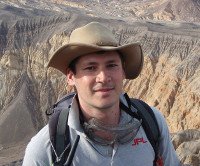David Flannery

Address:
4800 Oak Grove Drive
M/S 183-301
Phone:
818.354.0416Member of:
Biography
David is a field geologist with an interest in ancient ecosystems and habitable environments elsewhere in the solar system. He has studied early Earth environments from mineralogical, sedimentological and paleontological perspectives, and is currently Science Test Lead for the Planetary Instrument for Lithochemistry, a mapping X-ray fluorescence spectrometer selected for the Mars 2020 rover contact science payload.
Education
- Ph.D., University of New South Wales, Sydney, Australia
- M.Phil., University of New South Wales, Sydney, Australia
- B.Sc. Macquarie University, Sydney, Australia
Research Interests
- Fieldable Micro-X-ray Fluorescence
- In-situ Analysis of Microbial Biosignatures
- Life in Extreme Modern Environments
- Archean Geobiology
Selected Awards
- D.I Groves Award (GSA)
Selected Publications
- D. T. Flannery, A. C. Allwood, W. T. Elam, R. Hodyss, D. R. Thompson and L. Wade. 2015. MicroXRF Analysis of Astrobiologically-Significant Geological Samples. Advances in X-ray Analysis (in press).
- David Thompson, David Flannery, Anantha Ravi Kiran, Abigail Allwood, Brian D. Bue, Benton C. Clark, W. Timothy Elam, Tara Estlin, Robert Hodyss, Joel A. Hurowitz, Yang Liu, and Lawrence Wade. 2015. Automating X-ray Fluoresence Analysis for Rapid Astrobiology Surveys. Astrobiology. November 2015, 15(11): 961-976. doi:10.1089/ast.2015.1349.
- Allwood, B. Clarke, T. Elam, D. Flannery, M. Foote, J. Hurowitz, E. Knowles and L. Wade. 2015. Texture-specific elemental analysis of rocks and soils with PIXL: The Planetary Instrument for X-ray Lithochemistry on Mars 2020. Proceedings of the IEEE Aerospace Conference 2015, 1-13.
- J. William Schopf, Anatoliy B. Kudryavtsev, Malcolm R. Walter, Martin J. Van Kranendonk, Kenneth H. Williford, Reinhard Kozdon, John W. Valley, Victor A. Gallardo, Carola Espinoza and David T. Flannery. 2015. Sulfur-cycling fossil bacteria from the 1.8-Ga Duck Creek Formation provide promising evidence of evolution's null hypothesis. Proceedings of the National Academy of Sciences. 112(7), 2087-2092
- Y. Hoshino, D. T. Flannery, M. R. Walter and S. C. George. 2014.Hydrocarbons preserved in a ~2.7 Ga outcrop sample from the Fortescue Group, Pilbara Craton, Western Australia. Geobiology. 13(2), 99-111. doi: 10.1111/gbi.12117
- Coffey, J. M., Flannery, D. T., Walter, M. R., and George, S. C., 2013. Sedimentology, stratigraphy and geochemistry of a stromatolite biofacies in the 2.72 Ga Tumbiana Formation, Fortescue Group, Western Australia. Precambrian Research. 236, 282-296.
- Sim M.S., Liang B., Petroff A.P., Evans A., Klepac-Ceraj V., Flannery D.T., Walter M.R., Bosak T. 2012. Oxygen-Dependent Morphogenesis of Modern Clumped Photosynthetic Mats and Implications for the Archean Stromatolite Record. Geosciences, 2(4):235-259.
- Peynot T. Li R., Flannery D.T. 2012. Mawson the Astrobiologist Rover: toward automatic recognition of Stromatolites. Proceedings of i-SAIRAS 2012: The 11th International Symposium on Artificial Intelligence, Robotics and Automation in Space. Turin, Italy.
- Flannery D. T., Hoshino Y.,Walter M.R., George S.C. 2012. Field Observations Relating to the ~2.74Ga Mopoke Member, Kylena Formation, Fortescue Group. Geological Survey of Western Australia, Record 2012/. 22p.
- Flannery D. T., Walter M. R. 2011. Archean tufted microbial mats and the Great Oxidation Event: new insights into an ancient problem. Australian Journal of Earth Sciences, 59, 1, 1-11.
- Flannery, D. T., 2009. Global Darwin: ideas blurred in early eastern translation. Nature (Correspondence), 464, 984.